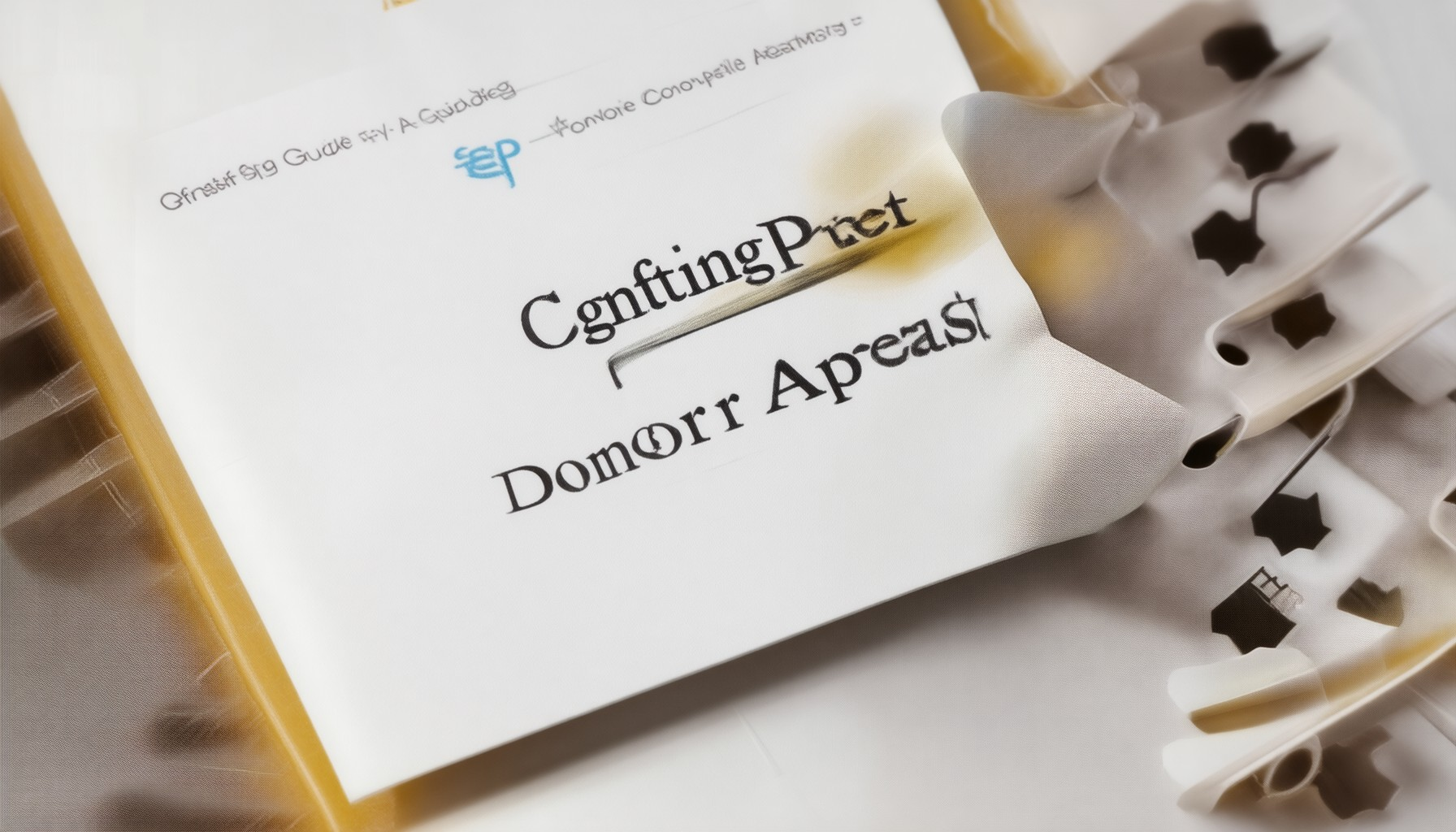Donor appeals play a pivotal role in the success of nonprofit organizations, serving as a cornerstone for securing vital resources and fostering meaningful connections with supporters. Crafting compelling donor appeals is not merely a task but an art form that requires strategic thinking, empathy, and a deep understanding of your audience. Whether you’re approaching this for the first time or looking to refine your existing strategies, this guide offers a comprehensive roadmap to help you create donor appeals that resonate deeply with your audience. From mastering the fundamentals of donor appeal letters to exploring advanced tactics for online outreach and optimizing PDF formats, this step-by-step guide equips you with the tools and knowledge needed to craft persuasive appeals that inspire action and drive impact. By aligning your messaging with organizational goals and leveraging the power of emotion, you can elevate your donor appeals to new heights, ensuring your mission continues to thrive. Whether you’re a seasoned fundraiser or new to the field, this guide provides actionable insights and real-world examples to help you make your donor appeals as effective as possible.
Key Takeaways
– Personalization Drives Engagement: Address donors by name and acknowledge their contributions to create a genuine connection.
– Clear Purpose Powers Impact: Immediately communicate the cause’s urgency or specific needs to inspire action.
– Storytelling Captivates Hearts: Share compelling narratives of lives changed by your mission to evoke empathy and motivation.
– Strong Calls to Action Secure Support: Provide clear, convenient methods for donors to contribute, such as online payments or donation buttons.
– Gratitude Strengthens Loyalty: Express sincere thanks to deepen donor relationships and encourage future contributions.
– Trust-Building Through Transparency: Share mission details, program outcomes, and financial accountability to gain donor trust.
– Visuals Enhance Appeal: Use images, videos, or links to provide vivid evidence of your cause’s impact.
– Optimization Fuels Success: Continuously test and refine appeals based on performance metrics for maximum effectiveness.

How to Write an Appeal for Donation
To craft a compelling donation appeal, follow these steps:
- Start with a Clear Purpose
- Share Your Story
- Explain the Cause
- Build Trust
- Offer Donation Options
- Appeal to Their Values
- Provide Incentives
- End with a Call to Action
Clearly state the purpose of your request. Whether it’s for a charity, community project, or personal cause, explain why the funds are needed and how they will be used.
Include a brief narrative about your mission or initiative. Make it relatable and emotional to engage readers.
Provide detailed information about the problem you’re addressing and how the donation will solve it. Highlight the impact the funds will have.
Introduce your team or organization. Include bios or credentials to establish credibility. Explain how the funds will be managed and accounted for.
Make it easy for people to contribute. Provide multiple ways to donate, such as online payments, checks, or in-kind gifts. Include a direct link to your donation page if available.
Connect the cause to the donor’s values or interests. Show how their contribution will make a difference and align with what they care about.
If possible, offer recognition or perks for their donation. Mention how contributors will be acknowledged, whether through thank-you notes, social media mentions, or exclusive updates.
Urge them to take immediate action. Use a clear and compelling closing statement that includes a link to your donation page or contact information.
For example:
Example Appeal
Dear [Recipient’s Name],
We are reaching out to ask for your support in helping us achieve our goal of providing clean water access to underserved communities around the world. Your donation will directly fund the construction of water purification systems in regions affected by waterborne diseases.
By contributing $XX, you can help transform lives and give hope to families who have been struggling to access safe drinking water. Every dollar goes towards materials, labor, and maintenance to ensure long-term impact.
Our team, comprised of experienced engineers and community organizers, has successfully implemented similar projects in 15 countries. We are committed to transparency and ensuring every donation is used effectively.
Click below to make your gift today:
We cannot achieve this without your generous support. Together, we can make a lasting difference.
Thank you for considering this request. Your kindness and compassion mean the world to us.
Sincerely,
John Doe
CEO, Clean Water Foundation
Always tailor your appeal to the specific audience and ensure it aligns with their interests and values. Keep the tone heartfelt yet professional, and make it easy for them to take action.
How to Make a Good Appeal for Requesting Funds
To craft an effective appeal for requesting funds, follow these organized steps:
- Purpose and Clarity
- Clearly state the reason for seeking funds.
- Specify the amount needed and intended use.
- Passion and Commitment
- Express genuine enthusiasm for your cause.
- Highlight your dedication and belief in the mission.
- Highlight Past Successes
- Mention previous achievements and successful projects.
- Showcase your track record of effective fund utilization.
- Detailed Utilization Plan
- Breakdown the budget into specific categories.
- Explain how funds will be allocated (e.g., programs, overhead).
- Competitor Overview
- Identify competitors and their approaches.
- Emphasize unique value proposition of your appeal.
- Audience-Tailored Messaging
- Adapt the appeal to resonate with different audiences.
- Consider donors’ interests, e.g., social impact vs. environmental focus.
- Strategic Timing
- Choose a timing that aligns with donor likelihood to contribute.
- Consider seasons or events when giving is prevalent (e.g., holidays).
- Clear Call to Action
- Provide multiple ways to donate (e.g., online, check, matching gifts).
- Include easy-to-follow instructions for contribution.
- Professional and Sincere Tone
- Balance professionalism with sincerity and authenticity.
- Use a positive and hopeful tone throughout.
- Storytelling Element
- Incorporate stories to engage and inspire donors.
- Share impactful narratives of change made possible by past donations.
- Medium Consideration
- Tailor the appeal based on the medium (email, letter, social media).
- Ensure content fits the platform for maximum engagement.
- Conclusion and Gratitude
- Thank potential donors for their consideration.
- Express confidence in the shared vision and future impact.

How to Persuade Donors
persuading donors is a crucial aspect of fundraising and building strong relationships with supporters. Here are proven strategies to effectively convince potential donors to contribute to your cause:
- Build Trust and Relationships: Donors are most persuaded by organizations they trust. Regular communication, transparency, and authenticity foster long-term relationships.
- Clearly Articulate Your Cause: Make it easy for donors to understand why your organization matters. Share stories, statistics, and the immediate impact their contributions will have.
- Appeal to Their Values: Align your messaging with the donor’s personal values and beliefs. Show how their donation aligns with what they care about.
- Offer Incentives: While not always the primary motivator, incentives like recognition or exclusive opportunities can encourage donations.
- Personalize the Appeal: Tailor your approach to individual donors based on their interests, giving history, and demographics.
- Create a Compelling Call to Action: Use clear, urgent, and specific language to motivate donors to take action.
- Utilize Emotional Appeals: Stories and visuals that evoke emotions are powerful tools in persuading donors.
- Highlight Impactful Stories: Showcase real-life success stories of individuals or communities your organization has helped.
- Ask for Support at the Right Time: Timing is critical. Approach donors when they are most receptive to giving.
- Provide Multiple Giving Options: Offer flexible ways for donors to contribute, such as online donations, recurring gifts, or in-kind donations.
By combining empathy, clarity, and strategic communication, you can effectively persuade donors to support your mission and create a lasting impact.

What is a Donor Appeal Letter?
A donor appeal letter is a personalized communication tool used by nonprofit organizations to engage and request donations from individual or organizational donors. These letters are typically written to steward existing donors, cultivate new prospects, or re-engage past contributors who may have lapsed in their support. The primary goal of a donor appeal letter is to inspire, educate, and prompt action, encouraging donors to contribute to your cause.
Key Components of a Donor Appeal Letter
- Personalization :
Address the donor by name and acknowledge their previous contributions. This helps establish a connection and makes the appeal feel more genuine and personalized. - Clear Purpose :
Clearly state the reason for the appeal. Whether it’s supporting a specific program, addressing an urgent need, or celebrating a milestone, the purpose should be immediately apparent. - Storytelling :
Include a compelling narrative that highlights the impact of the donor’s contributions. Share stories of individuals or communities that have been positively affected by your organization’s work. - Call to Action :
Provide a clear and concise request for support. Specify how the donor can make their contribution, whether through a donation button, check, or online payment. - Gratitude and Recognition :
Express sincere thanks for the donor’s past support and reinforce their importance to your mission. This strengthens the relationship and encourages continued engagement. - Trust-Building Elements :
Include information about your organization’s mission, impact, and financial accountability. Transparency builds trust and assures donors that their contributions are used effectively.
Examples of Common Appeal Letters
- Mid-Year Appeal : Sent around July or August, these letters often highlight progress made in the first half of the year and outline upcoming goals.
- End-of-Year Appeal : Typically sent in December or January, these letters encourage donors to make year-end contributions, which are often tax-deductible.
- Crisis or Urgent Appeal : Used in response to natural disasters, health crises, or other emergencies, these letters emphasize the immediate need for support.
- Re-engagement Appeal : Sent to donors who haven’t contributed in the past year, these letters aim to reconnect and rekindle their interest in your cause.
Tips for Writing Effective Donor Appeal Letters
- Keep It Simple and Direct : Avoid lengthy paragraphs or jargon. Focus on clarity and conciseness to capture the donor’s attention quickly.
- Use a Strong Subject Line : Make the subject line compelling and specific to grab the donor’s interest.
- Include Visuals or Links : Attach images, videos, or PDFs that further illustrate your cause and its impact.
- Test and Optimize : Track the performance of your appeal letters and adjust content based on donor feedback and engagement rates.
By crafting thoughtful and strategically targeted donor appeal letters, your organization can strengthen donor relationships, increase engagement, and secure vital funding to support your mission.
How to Write a Powerful Appeal Letter
A well-crafted appeal letter can make a significant difference in achieving your goals, whether it’s securing funding, advocating for a cause, or influencing a decision. Here’s a step-by-step guide to writing an effective appeal letter:
- Start with a Clear Subject Line:** Capture attention immediately with a compelling subject line that highlights the urgency or importance of your appeal. Example: “Urgent Appeal for Critical Funding” or “Immediate Action Required for [Cause].”
- Address the Recipient Respectfully:** Begin the letter with a polite greeting and introduce yourself or your organization briefly. State your purpose clearly and concisely.
- Explain the Issue and Why It Matters:** Clearly articulate the problem or challenge you’re facing. Provide background information and explain why your cause is important. Use emotional and logical appeals to connect with the reader.
- Outline the Request:** Clearly state what you are asking for. Be specific about the type of action you want the recipient to take, whether it’s donating, volunteering, signing a petition, or supporting a policy change.
- Include a Call to Action:** Make it easy for the reader to respond. Provide clear instructions on how to take action, such as visiting a website, emailing a decision-maker, or calling a number. End with a polite reminder of the deadline if applicable.
- Add a Personal Touch:** Share a personal story or testimonial to add credibility and emotion to your appeal. This helps readers connect with your cause on a deeper level.
- End with Gratitude and Encouragement:** Thank the recipient for their potential support in advance. Express confidence in the cause’s success and encourage them to spread the word if they get involved.
By following these steps, you can create an appeal letter that is both persuasive and professional, increasing the likelihood of achieving your desired outcome. Remember to tailor each letter to the specific audience and keep it concise to maintain the reader’s attention.

How to Appeal to Donors
To effectively appeal to donors, consider the following organized approach:
1. Clearly Define Your Cause
Start by articulating the mission and impact of your organization. Make it easy for donors to understand how their contributions will directly benefit your cause. Highlight the specific programs or initiatives their donations will support.
2. Utilize Storytelling
Share compelling stories or testimonials from beneficiaries. Personal narratives create an emotional connection and demonstrate the tangible difference donations can make. For example:
- Describe how a previous donation transformed lives.
- Share success stories to illustrate program outcomes.
3. Personalize the Appeal
Tailor your messaging to resonate with the unique interests and values of your target audience. Consider factors like age, location, and past giving history to craft personalized appeals. For instance:
- Offer options aligned with donors’ interests, such as education or health initiatives.
- Use data-driven insights to segment your audience effectively.
4. Employ Emotional Appeals
Appeal to emotions by emphasizing the urgency and importance of the cause. Highlight potential consequences of inaction or the positive outcomes achievable with their support. For example:
- Explain the immediate need for resources or funding.
- Paint a vivid picture of the future impact of their contribution.
5. Recognize and Reward Donors
Acknowledge contributions publicly to foster loyalty. Provide updates on how their donations are utilized and express genuine gratitude. This builds trust and encourages future support. For example:
- Publicly thank donors in newsletters or on social media.
- Share progress reports detailing the impact of their gifts.
6. Establish Feedback Loops
Engage donors by seeking their input and feedback. Use surveys or thank-you notes to understand their preferences and concerns. This helps tailor future appeals to their interests. For example:
- Conduct donor satisfaction surveys.
- Send personalized thank-you letters with follow-up information.
Conclusion
A successful donor appeal hinges on clear communication, emotional resonance, and personalized engagement. By aligning your messaging with donor values and maintaining transparency, you can inspire greater contributions and build lasting relationships with your supporters.





0 Comments